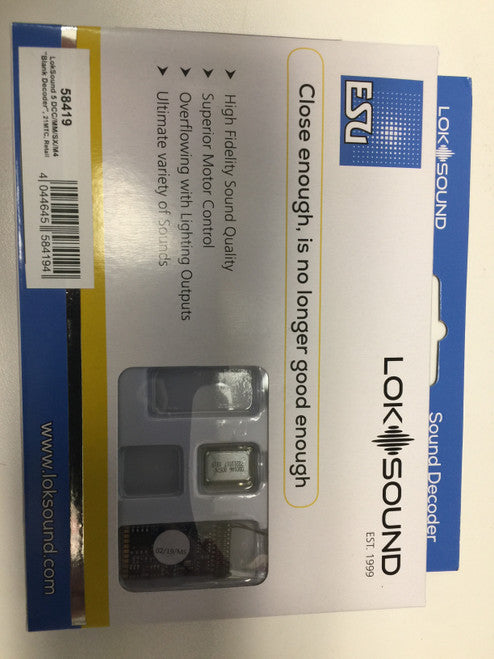ESU 58419 LokSound / Ver 5 Multiprotocal 21-Pin Generic Ready for Programming - (All Scales) Part # = 397-58419
$107.99 $34.00
Save: 69% off
-
Free standard home delivery on all orders
-
90 Days Easy Returns
View More Return Policy
-
Delivered within 3 - 7 days (excludes Public holidays).
Description
The ESU 58419 LokSound Version 5 is a multi - protocol 21 - pin 'Generic' decoder suitable for all scales, with part number 397 - 58419. It's a LokSound 5 DCC/MM/SX/M4 'blank decoder' paired with an 11x15mm speaker. It's ready for programming, but no programming is done initially. If you need a sound file loaded onto the decoder, Yankeedabbler will do it for free. Just add the sound file number or locomotive type (e.g., GP38) in the 'add order note' in the lower - left corner of your cart. Otherwise, the decoder will be sent to you directly, and you'll need to program it. You can view the ESU Sound Library by clicking this link (North American and AUS Files: https://projects.esu.eu/projectoverviews/18). We can load any ESU sound file, just tell us the file number or locomotive type. You can also buy a LokProgrammer from us (stock number 53452), though it's not always necessary as decoders can come pre - loaded with sound files and CV changes can be made via control systems. This decoder is for HO gauge and fits most HO scale locomotives. It offers 'Full Throttle' decoder operation for diesels. To deal with the limitations of BEMF in simulating loads, it has unique 'Full Throttle' features like 'Drive Hold', 'Run 8', 'Coast', improved 'Dynamic Brakes', and a new 'Independent Brake' feature. The V5 decoder supports all DCC programming modes and, with RailCom®, you can read CV values on the main if your command station supports it. It also supports Märklin® braking sections, ZIMO® HLU braking commands, Lenz® ABC system, and can brake with DCC brake generators or DC. It's suitable for analog DC operation, AC, and DCC command control. The LokSound V5 can reproduce up to 10 channels simultaneously with high - quality audio. Its dual class D audio power amplifier with 3W output power works with 4 - 32 Ohms speakers, and the 128 MBit sound memory provides ample storage. You can adjust the volume of each sound fragment separately. Each LokSound V5 has at least 10 amplified outputs with multiple lighting functions, and the brightness of each output can be adjusted. Decoders with a PluX22 or 21MTC interface have 4 additional outputs. The LokSound V5 DCC decoder supplies up to 1.5A motor current. Its motor control is improved with a variable PWM pulse frequency from 10 kHz to 50 kHz for silent operation. Load control can be adjusted with up to 10 separate CVs, and the 'Auto - Tune' function calibrates the decoder to match the motor.

Using the ESU 58419 LokSound Version 5 decoder is a breeze. First, if you want a specific sound file on it, add the details in the 'add order note' when you place your order. Yankeedabbler will load it for free. If you don't do this, you'll need to program the decoder yourself. You can refer to the ESU Sound Library (link provided) to choose the right sound file. When it comes to installation, this decoder is designed to fit most HO scale locomotives. It's suitable for different types of operation, including analog DC, AC, and DCC command control. For programming, it supports all DCC programming modes. If your command station has RailCom® support, you can read out the CV values on the main. Regarding the sound, it can play up to 10 channels at once with great quality. You can easily adjust the volume of each sound fragment. The lighting functions are also customizable, with at least 10 amplified outputs where you can set the brightness as you like. The motor control is another great feature. With the variable PWM pulse frequency, it runs quietly, especially for coreless motors. The 'Auto - Tune' function helps the decoder match the motor automatically. Now, for the notes. Make sure to handle the decoder gently as it's a delicate electronic device. When programming, follow the instructions carefully to avoid errors. For maintenance, keep it in a dry and clean place. If you have any issues with the sound, motor control, or programming, check the connections first. If the problem persists, you can contact our support team for further assistance.